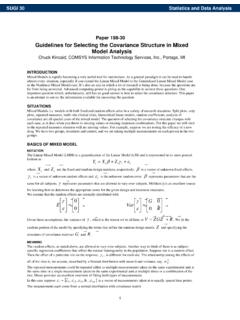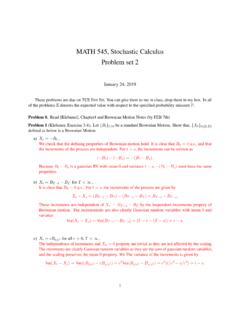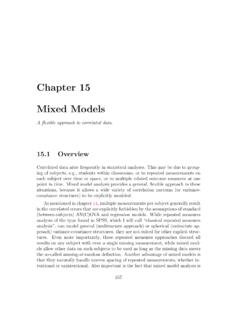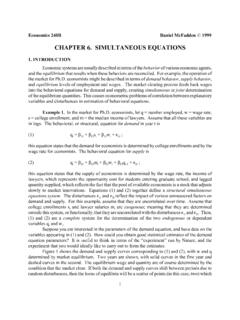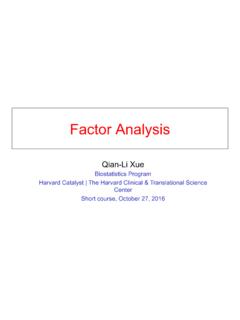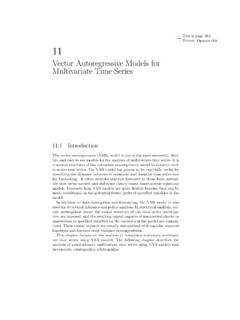Transcription of 188-29: Repeated Measures Modeling with PROC MIXED
1 1 Paper 188-29 Repeated Measures Modeling With PROC MIXED E. Barry Moser, Louisiana State University, Baton Rouge, LA ABSTRACT PROC MIXED provides a very flexible environment in which to model many types of Repeated Measures data, whether Repeated in time, space, or both. Correlations among measurements made on the same subject or experimental unit can be modeled using random effects, random regression coefficients, and through the specification of a covariance structure . PROC MIXED provides a large variety of useful covariance structures for Modeling covariation in both time and space, including discrete and continuous increments of time and space. MANOVA tests are available for some model specifications, and degrees of freedom adjustments are available to provide better approximations to the distributions of the test statistics than for standard between- or within-subject methods.
2 The %GLIMMIX macro, available in the SAS/STAT sample library, extends the MIXED model technology of PROC MIXED to generalized linear MIXED models, while the %NLINMIX macro, also available in the SAS/STAT sample library, provides a similar framework for non-linear MIXED models. Likelihood and information criteria are available to aid in the selection of a model when the model structure is not known a priori. INTRODUCTION Repeated Measures data are encountered in a wide variety of disciplines including business, behavioral science, agriculture, ecology, and geology. What generally distinguishes Repeated Measures data from time series data is that multiple subjects are involved, and the number of measurements per subject is generally not very large. The amount of literature on Repeated Measures analysis is now quite large (see the references section for some recent books on the topic), partly as a result of advances in statistical computing that permit the use of methods that are often quite computational in detail.
3 The reason for the large number of publications and software solutions is that there is no simple methodology that accommodates all facets of Repeated Measures experiments and surveys. For example, Repeated Measures experiments may measure each subject at each of a designated set of equally spaced times, while another experiment may result in the number of measurements per subject as a random variable with measurements made at irregularly spaced times. Other experiments may have drop outs while the experiment progresses. The drop outs may be random, or may be a result of the treatment that the subject receives. In some experiments, the Repeated Measures factor can be randomized, while in others, the Repeated Measures factor is time or space and cannot be randomized. In addition, the response variable or variables may be continuous, discrete, or a combination of the two, leading to different possibilities for making inference from the experiment or survey.
4 PROC MIXED in the SAS System provides a very flexible Modeling environment for handling a variety of Repeated Measures problems. Random effects can be used to build hierarchical models correlating measurements made on the same level of a random factor, including subject-specific regression models, while a variety of covariance and correlation structures can be specified for residuals. The random effects and covariance structures are specified in the RANDOM and Repeated statements, respectively. RANDOM STATEMENT The RANDOM statement specifies the random effect terms that are to be included in the model, along with a covariance structure (TYPE= option) to specify how the random effects are related to each other. More than one RANDOM statement can be used to define a PROC MIXED model.
5 This is useful when you have some random effects that are correlated, while there are others that need to be independent of those, as in hierarchical models. The SUBJECT= option can be used to specify different hierarchies. Repeated STATEMENT The Repeated statement controls the covariance structure imposed upon the residuals or errors. In procedures such as GLM and REG, the errors are assumed to be independent, while PROC MIXED has a rich variety of structures to specify relationships among the errors. In Repeated Measures models the SUBJECT= optional statement parameter is used to define which observations belong to the same subject, and which belong to different subjects, where different subjects are independent. The TYPE= optional statement parameter specifies the model for the covariance structure of the errors.
6 The GROUP= optional statement parameter permits different levels of the GROUP effect to have different structure parameters, though the structure TYPE remains the same. Only one Repeated statement is permitted in a PROC MIXED model. RANDOM EFFECTS Example 1 is taken from Lindsey (1993:86) and concerns the visual acuity of eyes and lens strength. Response times in msec of seven subjects were measured after a light is shown into each eye under each of 4 lens powers, 6/06, 6/18, 6/36, and 6/60, where the power is the perception of the object by the eye at 6 feet when it is actually positioned at 6, 18, 36, or 60 feet, respectively. The question of interest is whether response time varies with lens strength. Assume that the 8 lens/eye combinations are completely randomized separately for each subject, and that there is no SUGI 29 Statistics and Data Analysis2 carryover effect.
7 A carryover effect would be present if the response time of a measurement depended upon the treatment previously applied. PAIRED MEASUREMENTS If we were to analyze the data only for the 6/06 lens power with an interest in comparing the left eye with the right eye, then we would have 2 measurements made on each subject one on the left eye and one on the right eye. Measurements made on the same subject are likely to be correlated, while it seems reasonable to believe that the response observed on one subject is independent of that observed on another subject. A typical analysis of this data would be with a paired t-test (or a non-parametric analog). In the paired t-test, we are estimating the population mean difference of left- and right-eye responses, LR , using the sample mean difference, LRYY.
8 The variance of this difference of means is ()22 Var2 LRLRLRYY =+ (1) where 2L , 2R , and LR are the variances and covariance of the left and right eyes. Unlike the two-independent samples problem, the covariance term is present and Measures the linear dependence between the left and right-eye measurements. An experimental design model that results in this same variance of the difference of means is the randomized block design (RBD) model. This model can be written as ijijijYB =++ + (2) where ijYis the response measured on the ith eye, i=[Left, Right], on the jth subject, is the overall mean, is the mean effect of eye, Bis the random subject effect, is the error, and ()20,jBBN , ()20,ijN , and jBand ij are independent.
9 This model can be fitted in a straightforward way using PROC MIXED . The MODEL statement will be used to specify the ,i while the RANDOM statement will be used to specify that the jBare to be included and used to estimate2B . The model defaults to include an intercept term, , and errors ij . Proc MIXED Data=Vision; Where LensStrength="6/06"; Class Subject Eye; Model ResponseTime = Eye; Random Subject / V VCorr; LSMeans Eye; Run; The random effects are estimated to be and for the subject and error, respectively. The V and VCORR options of the RANDOM statement produce tables showing the estimated covariance and correlation matrices of the responses. These matrices for the first two subjects only are given in the tables below. Table 1. covariance matrix for subjects 1 and 2.
10 Row C o l 1 Col2 Col3 Col4 1 2 3 2. Correlation matrix for subjects 1 and 2. RowCol1 Col2 Col3 Col4 3 In these tables Col1 and Col2 refer to measurements made on subject 1, while Col3 and Col4 refer to the measurements made on subject 2. Further Col1 and Col3 correspond to the left eye and Col2 and Col4 to the right eye. We observe here that measurements made on the same subject are allowed to be correlated (r= ), while measurements between different subjects are independent (absence of covariances and correlations). However, we note that this model requires that the variances of the left and right eyes be equivalent, which does not quite match the variance of the differences of the mean model proposed earlier.










